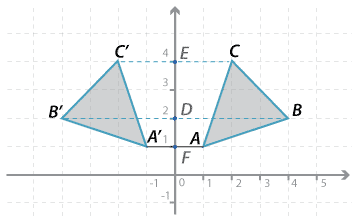![]()
Reflection in the y-axis
The point \(A\) in the diagram above has been reflected in the \(y\)-axis. To reflect \(A\), a line has been drawn at right angles to the axis of reflection (the \(y\)-axis in this case) and a ruler or compass used to mark \(A^\prime\) the same distance from the axis of reflection, but on the other side. Similarly for \(B\) and \(C\).
Using coordinates we can describe the reflection of the vertices:
\(A(1,1) \rightarrow A^\prime (−1, 1); B(4, 2) \rightarrow B^\prime (−4, 2); C(2, 4) \rightarrow A^\prime (−2, 4)\).
In general, \(P(x, y) \rightarrow P^\prime (−x, y)\).





